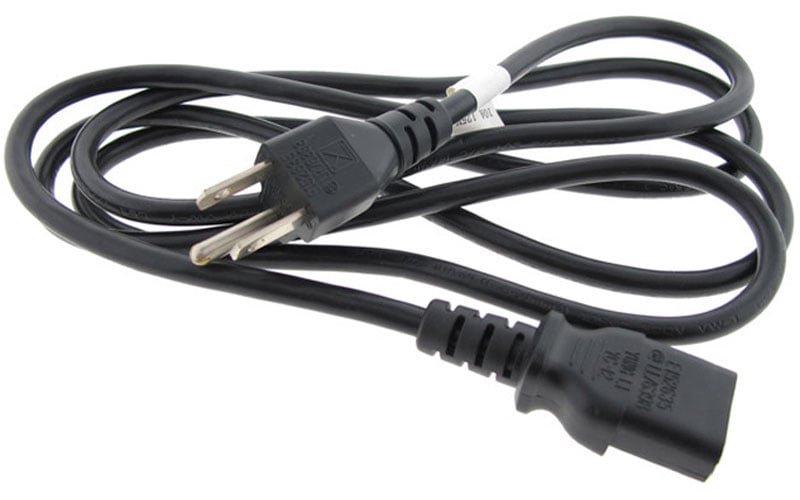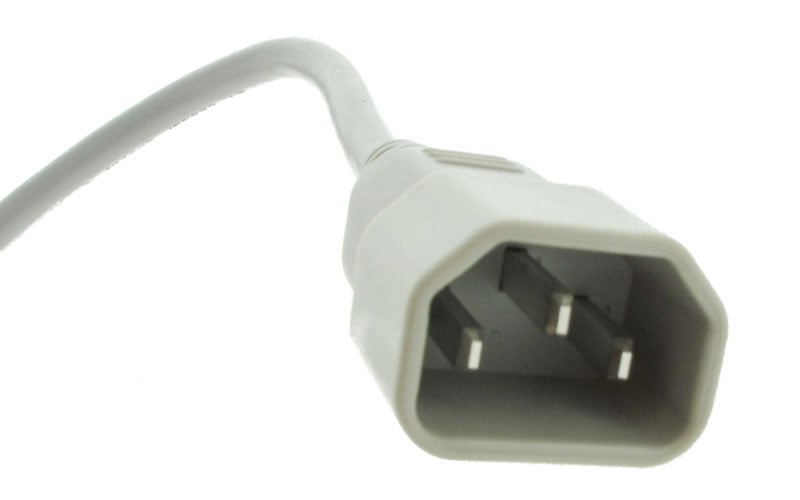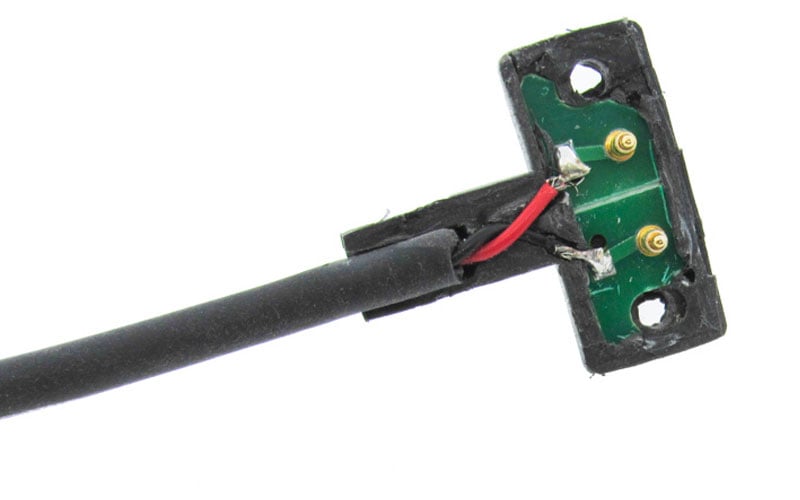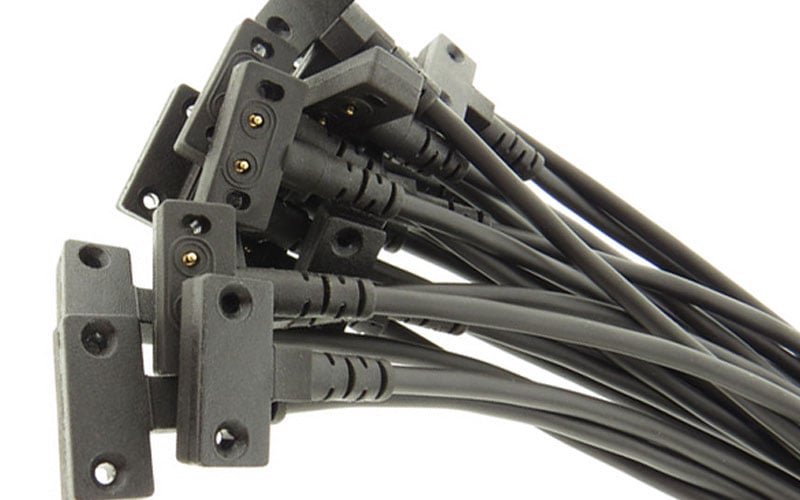Overmolded cable assemblies are extremely common and used for several reasons throughout the electronics industry. The process of overmolding is inexpensive, completely customizable, and, most importantly, produces a rugged and robust part.
Engineers can push the limits and develop custom tools and assembly apparatus that add functionality to even the simplest of overmolds. Cable overmolding has dramatically changed the popularity and performance of cable assemblies over the last several decades.
Overmolding provides engineers the ability to encapsulate PCBs and other electromechanical components within a sealed volume. These processes use tooling to locate an item or wire within a fixture and then envelop it with molten thermoplastic to make a part. Once the material cools, it can be safely removed from the tool. Because the exposed electrical contacts are now covered with insulating thermoplastic, they are sealed off from the outside and are now impervious to fluids and the elements. The finished cable assembly is now able to withstand exposure to harsh environments while also being able to withstand shock, vibration, and continual flexing without damage to the delicate components within.

NEMA 5-15P power cable with overmolded connectors.
The sky is truly the limit when it comes to design options for overmolded cables. Designers can add small lights to show when the cable is energized. PCBAs can be embedded within the overmold to become “smart”. Magnets can be bonded to the overmold to help improve the mate and fitment to another part. Still, with all these options to consider, some of the most common overmolded cable designs use the simplest of components- pins, plugs, receptacles, and spring-loaded contacts.
Overmolded Pins and Contacts
Once an overmolded connector concept is selected, engineers must choose from the various types of pin and contact options that exist. Also known as a terminal, this pin or contact should be sized for the maximum current draw with margin. Power requirements are among the most critical design requirements since an undersized pin or contact can damage the connector or worse create an electrical fire risk. Off-the-shelf pins and contacts can be chosen, while custom machined or stamped pins can be considered if production volumes are sufficient and justify the investment.
Both crimp and solder terminations are appropriate ways to affix the terminal to the wire, with each having its own pros and cons. Automation can help speed up processing, but these remain largely manual steps. The one consideration to note about choosing between crimp contacts and solder contacts is that most crimp contacts will require specialty tooling to pinch the crimped connector onto the wire. Once the pins and contacts are properly connected to the wire and there is a robust electrical connection, they can be placed within production tooling to complete the overmold process.
There are times when pins and contacts must be fixed within an overmold and using an intermediary PCB is the best option to build the part. This can help decrease material costs, reduce labor, and help control tight tolerances and dimensions, especially relating to the spacing between contacts also known as the pin pitch. Typically, the pins or contacts are batch soldered into a rigid printed circuit board that is then connected to a set of wires. This entire subassembly is carefully loaded into custom-designed overmold tooling and then the molten material is shot into the mold. Once cooled, the completed part can be removed from the tool and is then ready for installation.
Overmolded Receptacles and Plugs
Overmolding receptacles and plugs are straightforward and similar to the process for overmolding pins and contacts. Most receptacles and plugs already come with an existing connector housing. Usually made of injection molded nylon, these housing types are universally available in a single row, dual row, and circular connector form factors. These housings are usually designed for wire-to-wire and wire-to-board mates.
However, one of the benefits to considering an overmolded solution is the fact that not all overmolded receptacles and plugs will need said separate housing to work properly. Instead, this family of overmolded receptacles and plugs relies on the overmolding step to fabricate the outer shell and connector housing. Most overmolded power cables that conform to NEMA and IEC standards feature these overmolded housing designs. Common examples include power cables per IEC 60320 C14, and NEMA 5-15P. Other common power cable designs include the male and female genders of 14-50, 14-30 and the dozens of other standard power cables for appliances, computers, and other household items.

IEC 60320 C14 power plug with molded shell.
Overmolded Spring-Loaded Contacts
For specialty applications, conventional pins and contacts can be replaced with spring-loaded versions and affixed to an overmolded connector. Widely known as pogo pins, these types of spring-loaded contacts are commonly used in many types of industrial electronics, consumer products, and electrical test apparatus. The benefits of using spring-loaded contacts vary with the application, though most advantages stem from the fact that these pogo pin devices have a constant preload force applied to the contact via the internal spring. This helps make a quick and robust electrical connection. Many pogo pin designs feature contacts that will only pass electrical current when the pin is fully engaged and depressed, making the interconnect live after the pin is pressed against another surface.

Spring loaded contact assembled to a rigid PCB …

… and then overmolded.
Their construction can vary, but most spring-loaded contact designs feature machined or drawn pins that are attached to one another via a pressed fit or swaged operation. Pogo pins have a barrel that is isolated from the bottom electrical contact, and when the spring is fully compressed, the barrel makes contact with a contact pad that completes the circuit.
Spring loaded contacts can be found on the charging stations for cordless drills, personal devices such as tablets and smart watches, and other consumer products that need a robust and safe electrical connection. Some products have the spring-loaded pins installed on to the overmolded connector, and others have the pins installed on the opposite part. Either way, if an overmold is required, a spring-loaded pin can be considered included as a solution.
Getting Started
As with any new design project, custom overmold solutions that include pins, receptacles, and spring-loaded contacts can solve many unique design challenges. But with this level of customization comes additional scrutiny and product safety concerns. For example, code prevents power cables with double male ends to reduce the risk of electrical shock. Custom designs that don’t need to explicitly comply to standards should still follow these best practices as a design principle.
Summary
Scrutinizing the design requirements for all exposed contacts, including both dry and wet electrical contacts, can help reduce the time to market and further decrease financial risk. More broadly, for any custom overmolded cable design, specifying critical project information such as the pin size, gender, polarity, shape, and plating requirements early can help streamline the development efforts to bring a truly custom overmold solution to market faster for less cost.
Key Takeaways
- Overmolding protects and seals electrical contacts, making cable assemblies rugged, moisture-resistant, and able to withstand vibration, shock, and environmental exposure.
- Pins and contacts must be sized for maximum current draw with margin, as undersized terminals create safety risks; crimp and solder terminations are both viable but require careful process control.
- Overmolded receptacles and plugs often eliminate separate housings, with the overmold itself forming the connector shell commonly used in NEMA and IEC power cable standards.
- Spring-loaded contacts (pogo pins) provide reliable, quick connections, commonly used in consumer devices, industrial electronics, and charging stations where robust repeatability is needed.
- Specifying design requirements early, such as pin size, polarity, plating, and compliance needs, reduces development risks and speeds time to market for custom overmolded solutions.
















